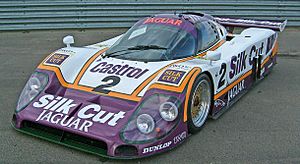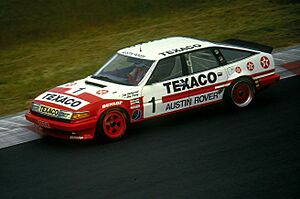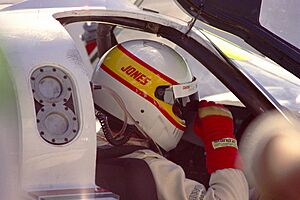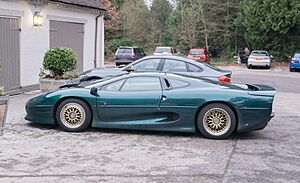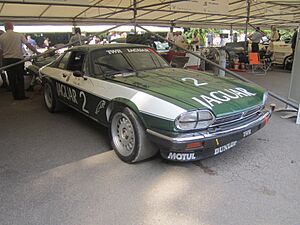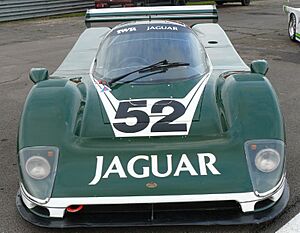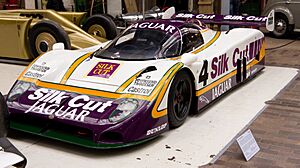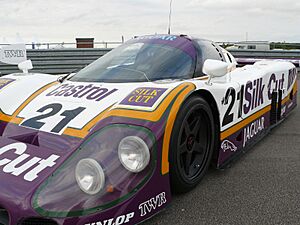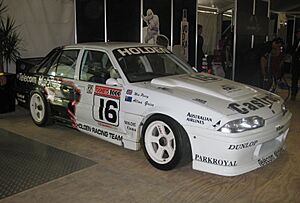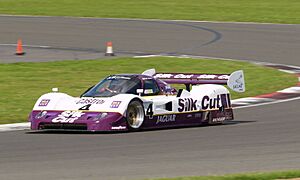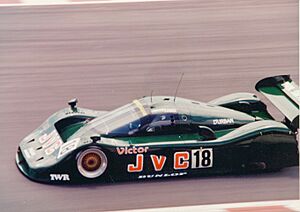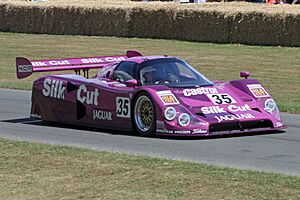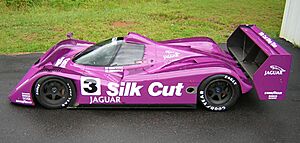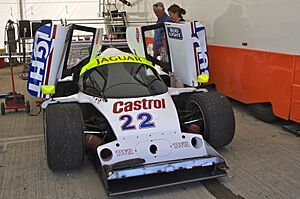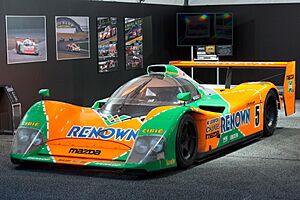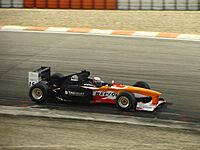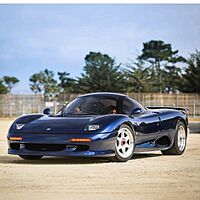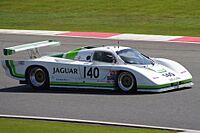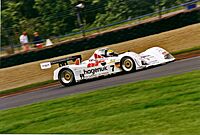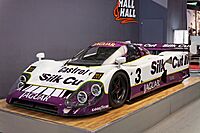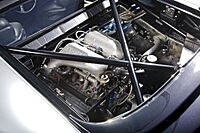Tom Walkinshaw Racing facts for kids
Tom Walkinshaw Racing (TWR) was a famous motor racing team and engineering company. It was started in 1976 by a racing driver named Tom Walkinshaw in England.
TWR first worked on cars for private racers. Then, they started building race cars for big companies like Mazda and Rover. But TWR became best known for its work with Jaguar. This partnership began in 1982 when they successfully raced the Jaguar XJS in the European Touring Car Championship, winning many races that year.
Their relationship grew, and by 1988, TWR-Jaguar won its first Le Mans race with the powerful V12-engined XJR-9. They won Le Mans again in 1990!
TWR and Jaguar even created a company called JaguarSport. They built special versions of Jaguar road cars, including the amazing XJ220 and XJR-15 sports cars. These were made at a new factory in Bloxham. When Ford bought Jaguar in 1989, TWR's work with Jaguar slowly ended. By 1994, JaguarSport closed, and the Bloxham factory started making Aston Martin cars instead.
TWR kept winning races with other car makers. They won Le Mans again in 1996 and 1997 with a Porsche-powered WSC-95. However, buying the Formula 1 team Arrows in 1996 cost a lot of money. This led to TWR closing down in 2002.
The TWR buildings and assets in the UK were bought by Menard Competition Technologies. These places were later used as headquarters for the Arrows, Super Aguri, and Caterham F1 teams. The Australian part of TWR was sold to Holden.
Today, there's a successful company in Australia called the Walkinshaw Group. It's run by Tom Walkinshaw's son, Ryan. This company grew from Tom's Holden Special Vehicles business. Ryan Walkinshaw has built a large company that makes many special vehicles for different car brands.
Contents
Racing Success: Touring and Sports Cars
TWR started by changing BMW 3.0 CSLs to make them faster. Soon, they were hired to lead Mazda's racing team in the British Touring Car Championship. The TWR-designed RX-7, driven by Win Percy, won the championship in both 1980 and 1981. Tom Walkinshaw himself also won the Spa 24 Hours race.
In 1982, TWR prepared a Range Rover that won the Paris-Dakar Rally. After this, TWR began working with British Leyland. They prepared the Jaguar XJS and Rover 3500 Vitesse for both the BTCC and European Touring Car Championship.
Winning many races with both cars led to a partnership to create a special Jaguar prototype for Group C racing. These cars would race in the World Sportscar Championship (WSCC) and the IMSA GT Championship (IMSA). John Egan, the chairman of Jaguar, wanted Jaguar to be famous again. He believed that returning to sports car racing would help Jaguar sell more cars around the world. By 1988, TWR was in charge of Jaguar's racing in both the WSCC and IMSA.
TWR Jaguar cars won the WSCC championship in 1987, 1988, and 1991. They also won the famous 24 Hours of Le Mans and the 24 Hours of Daytona in 1988 and 1990. Their first car in 1985 was the XJR-6, which had a carbon-fibre body and a powerful Jaguar V12 engine. The XJR-8 won the WSCC Team's Championship in 1987. The XJR-9 won the WSCC Team's Championship and Le Mans in 1988. The XJR-12, which was similar to the XJR-9, won Le Mans again in 1990.
TWR even developed its own engine for later cars like the XJR-10 and XJR-11. These used a 3.5-litre twin-turbocharged V6 engine, which was very powerful. However, this engine was not as good for 24-hour races, so the V12-powered XJR-12 was used for Le Mans and Daytona.
Rules for racing changed, making the 3.5-litre turbocharged cars less useful. So, TWR developed the brand-new XJR-14 for 1991. This car, designed by Ross Brawn, won both the WSCC Drivers' and Teams' championships. But Jaguar and most other manufacturers left the WSCC because of unfair rule changes.
In 1991, TWR also built the XJR-15 for special customers. This car was based on the Le Mans-winning XJR-9. It raced in its own series, the Jaguar Intercontinental Challenge. The XJR-15 was also legal to drive on the road, making it the only road car fully designed and built by TWR.
In Australia, Walkinshaw Racing competed in the Australian Touring Car Championship. They raced as factory teams for Holden Racing Team and HSV Dealer Team.
TWR changed its XJR-14 design into the TWR WSC-95 for Porsche. Porsche didn't use it in 1995, but in 1996, a team called Joest Racing entered it at Le Mans and won! They won again the next year in 1997.
In 1997, Nissan Motorsports asked TWR to help them develop the Nissan R390 GT1 race car. This car was a re-bodied XJR-15. In the 1998 24 Hours of Le Mans, all four Nissan cars finished the race, placing 3rd, 5th, 6th, and 10th.
Famous Team Members
TWR worked with many of the world's best drivers. Some of them include Win Percy, Martin Brundle, John Watson, David Coulthard, Jan Lammers, Johnny Dumfries, and Tom Kristensen.
Raul Boesel (1987), Martin Brundle (1988), and Teo Fabi (1991) all won the WSCC Driver's Championship while racing for TWR-Jaguar. TWR helped win Le Mans in 1988 for Andy Wallace, Johnny Dumfries, and Jan Lammers. They won again in 1990 for Brundle, Nielsen, and Cobb. In 1996, Davy Jones, Alexander Wurz, and Manuel Reuter won. And in 1997, Michele Alboreto, Stefan Johansson, and Tom Kristensen took the victory.
Many important motor-racing engineers also worked at TWR. These included Roger Silman, Tony Southgate, and Ross Brawn. Ian Callum was the design director for several years. TWR also worked with Peter Stevens, who designed the Jaguar XJR-15.
TWR in Formula One Racing
Tom Walkinshaw Racing was involved in Formula One from 1992 to 2002. First, Tom Walkinshaw became the engineering director for Benetton. He helped develop the car that led Michael Schumacher to win his first World Championship in 1994.
After some disagreements with Benetton boss Flavio Briatore, Walkinshaw moved to manage the Ligier team. He then bought most of the Arrows team in 1996. The next year, Arrows surprised everyone by signing World Champion Damon Hill. They also brought Bridgestone tyres into Formula One.
Even though the team almost won the 1997 Hungarian Grand Prix, Arrows struggled to find enough sponsors. Because TWR was the main owner of Arrows, when Arrows closed down, TWR soon followed in 2002. TWR Australia was quickly bought by Holden. The TWR technical centre in Leafield was sold and later became the headquarters for the Super Aguri and Caterham F1 teams.
Building Road Cars
In 1984, TWR created 'TWR Sport' to make highly modified versions of the Jaguar XJ-S. These cars, called XJR-S, used TWR's racing experience. They had better aerodynamics, improved suspension and brakes, and a tuned engine. TWR Sport was so successful that in 1988, TWR and Jaguar formed a joint company called 'Jaguar Sport'.
Jaguar Sport first focused on making special versions of Jaguar road cars. But there was a huge demand to build the concept car Jaguar XJ220. So, Jaguar Sport decided to design and develop this new sports car. A new factory was set up in Bloxham, Oxfordshire, and production started in 1990.
After TWR's Jaguar won Le Mans in 1988, many wealthy car fans asked Tom Walkinshaw to build a road-legal version of the XJR-9. He decided to produce a modified version of the XJR-9, which became the Jaguar XJR-15. This was a limited-edition road-going racing car. The XJR-15 was made in 1991 at Bloxham, alongside the XJ220.
TWR then took on the job of designing and developing the new Aston Martin DB7. This car was designed by Ian Callum and built at the old Jaguar Sport factory in Bloxham.
In 1996, TWR designed and built the Volvo C70 Coupé. Its engine was based on the one used in Volvo's touring cars.
TWR's last fully developed road car was the XJ220S. This was a limited-edition racing version of the XJ220, built between 1996 and 1997. TWR made the standard XJ220 much lighter by using carbon-fibre bodywork. They also added a special aerodynamic body kit and removed parts from the inside. A tuned engine with 680 horsepower completed this powerful car.
In 1987, Walkinshaw partnered with General Motors' Australian division, Holden. They brought back the Holden Dealer Team's performance and tuning division, which became Holden Special Vehicles.
TWR also worked for other car makers. They helped develop the Renault Clio V6 and the Saab 9-3 Viggen. TWR was also involved in MG Rover's plan to replace their old Rover 45/MG ZS. They were hired to redesign the Rover 75/MG ZT into a smaller car. However, because Arrows and TWR closed down, this project never went into production.
TWR in Motorcycle Racing (MotoGP)
In 1997, former motorcycle world champion Kenny Roberts started his own racing team and built a motorcycle. Roberts set up his company in England to use the knowledge from the Formula 1 industry. He asked Tom Walkinshaw Racing to help develop a special three-cylinder engine for his motorcycle. Even though the motorcycle never won a Grand Prix race, it did get a pole position (the best starting spot) with rider Jeremy McWilliams at the 2002 Australian Grand Prix.
Return to British Touring Car Championship
In 1994, TWR returned to the BTCC, working with Volvo. This partnership created the unique 850 Estate racing car. This car became less competitive when new rules in 1995 allowed other teams to use aerodynamic parts. TWR then built and raced the Volvo 850 Saloon, winning six races in 1995 and five in 1996. The S40 secured one win in 1997 in the BTCC.
In 1998, TWR Volvo won the British Touring Car Championship with Rickard Rydell driving the S40. TWR also helped design the road-going Volvo C70 coupe and convertible cars.
TWR-Developed Cars List
| Sponsor | Model | Series | Engine/Chassis | Image 1 |
|---|---|---|---|---|
| Mazda | RX-7 | BTCC, ETCC | Mazda 2.3 litre, rotary | |
| Rover | Vitesse | BTCC, ETCC | Rover 3.5 litre, normally aspirated | |
| Rover | Range Rover | Paris-Dakar | ||
| Jaguar | XJ-S | ETCC | Jaguar V12, 5.3 litre, normally aspirated TWR JC-84A #001,#002,#003,#004,#005,#006,#007 Engine designed by: Allan Scott |
|
| Jaguar | XJR-6 | WSCC | Jaguar V12, 6.2 litre, normally aspirated, 660BHP #185, #186, #285, #286, #385, #386 Chassis designed by: Tony Southgate Engine designed by: Allan Scott |
|
| Jaguar | XJR-8 | WSCC, Le Mans | Jaguar V12, 7 litre, normally aspirated, 750BHP #187, #287, #387 plus #186 & #286 re-developed as XJR-8LM Chassis designed by: Tony Southgate Engine designed by: Allan Scott |
|
| Jaguar | XJR-9 | WSCC, Le Mans | Jaguar V12, 7 litre, normally aspirated, 750BHP #488, #588, #688 Chassis designed by: Tony Southgate Engine designed by: Allan Scott |
|
| Jaguar | XJR-9 IMSA | IMSA | Jaguar V12, 7 litre, normally aspirated, 750BHP #188, #288, #388 Chassis designed by: Tony Southgate Engine designed by: Allan Scott |
|
| Holden | VL Commodore SS Group A SV | ETCC, BTCC, ATCC, AEC | Holden V8, 5 litre, normally aspirated, 500BHP |
|
| Jaguar | XJR-10 | IMSA | Jaguar V6, 3.0 litre, turbo-charged, 650BHP+ #389, #489, #589, #390, #690 Chassis designed by: Tony Southgate and Ross Brawn Engine designed by: TWR |
|
| Jaguar | XJR-11 | WSCC | Jaguar V6, 3.5 litre, turbo-charged, 750BHP+ #189, #289, #490, #590 #1190, #1290, #1390 Chassis designed by: Tony Southgate and Ross Brawn Engine designed by: TWR |
|
| Jaguar | XJR-11 | All Japan Sports Prototype Championship | Jaguar V6, 3.5 litre, turbo-charged, 750BHP+ #490, #590 Chassis designed by: Tony Southgate and Ross Brawn Engine designed by: TWR |
|
| Holden | VN Commodore SS Group A SV | ATCC, AEC | Holden V8, 5 litre, normally aspirated, 520BHP |
|
| Jaguar | XJR-12 | IMSA, Le Mans | Jaguar V12, 7 litre, normally aspirated, 750BHP XJR-12/190 and /290 were new chassis while chassis 588 renumbered XJ12-/990 and 288 (the GTP car which came 1st in the 1988 Daytona 24 Hours), was renumbered XJR-12/1090 Chassis designed by: Tony Southgate Engine designed by: Allan Scott |
|
| Jaguar | XJR-14 | WSCC, IMSA | Cosworth V8, 3.5 litre, normally aspirated, 650BHP+ #591, #691, #791, #192 Chassis designed by: Ross Brawn and John Piper Engine designed by: Cosworth |
|
| Jaguar | XJR-15 | Jaguar Intercontinental Challenge | Jaguar V12, 6 litre, normally aspirated, 450BHP XJR-15 / 50 cars manufactured, 16 raced, 001 -> 050 Designed by: Tony Southgate with body styling by Peter Stevens Engine designed by: Allan Scott |
|
| Jaguar | XJR-16 | IMSA | Jaguar V6, 3.5 litre, turbo-charged #191, #291 Designed by: Tony Southgate Engine designed by: TWR |
|
| Jaguar | XJ220C | Le Mans | Jaguar V6, 3.5 litre, turbo-charged, 500BHP (restricted) #839,#838,#837,#836 Chassis designed by: Keith Helfet, Jim Randle and Richard Owen Engine designed by: TWR |
|
| Nissan | R-390 (re-styled XJR-15) | Le Mans | TWR-Nissan V8, 3.5 litre, turbo-charged #R1, #R2, #R3, #R4 Designed by: Tony Southgate and Ian Callum |
|
| Porsche (Joest) | WSC-95 (re-styled XJR-14) | Le Mans | Porsche 3.0 litre Flat 6, turbo-charged #001, #002 Chassis designed by: Ross Brawn and John Piper |
|
| Mazda | MXR-01 (re-styled XJR-14) | WSCC | Mazda (Judd) V10, 3.5 litre, normally aspirated, 001,002,003,004,005 Chassis designed by: Ross Brawn and John Piper |
Motorsports Results
| Years | Series / Race | Associate Manufacturer | Cars | Driver(s) | Results | |
|---|---|---|---|---|---|---|
| 1980 - 1981 | British Touring Car Championship, European Touring Car Championship | Mazda | RX-7 | Win Percy, Pierre Dieudonné, Tom Walkinshaw, Chuck Nicholson | BTCC Championship winner (Percy), 1980 and 1981, ETCC winner 1981 | |
| 1982 | Paris-Dakar | Rover | Range Rover | Rene Metge, Bernard Giroux | Overall Winner (Metge, Giroux) | |
| 1981-1987 | British Touring Car Championship | Rover | Vitesse | Andy Rouse, Peter Lovett, Jeff Allam, Neil McGrath, Pete Hall, Dennis Leech, Graham Scarborough, Tim Harvey | Championship winner, 1983 (later DQ on technicality); Championship winner (Rouse), 1984 | |
| 1982-1984 | European Touring Car Championship | Jaguar | XJ-S | Tom Walkinshaw, Hans Heyer, Win Percy, Jean-Louis Schlesser, Enzo Calderari, Chuck Nicholson, Armin Hahne, Martin Brundle | 2nd in 1983, Championship winner (Walkinshaw), 1984. Spa 24 Hours winner (Walkinshaw, Percy, Heyer) 1984 | |
| 1984 | James Hardie 1000 | Rover | Vitesse | Jeff Allam, Armin Hahne, Steve Soper, Ron Dickson | 1st in class (Allam, Hahne) | |
| 1985 | James Hardie 1000 | Jaguar | XJ-S | Tom Walkinshaw, Win Percy, Jeff Allam, Ron Dickson, John Goss, Armin Hahne | Winner (Goss, Hahne), third place (Walkinshaw, Percy) and DNF | |
| 1985 | French Saloon Car Championship | Rover | Vitesse | Jean-Louis Schlesser | Championship Winner 1985 | |
| 1985-1986 | European Touring Car Championship | Rover | Vitesse | Tom Walkinshaw, Win Percy, Jean-Louis Schlesser, Eddy Joosen, Pierre-Alain Thibaut, Steve Soper, Hans Heyer, Martin Brundle, Gianfranco Brancatelli, Denny Hulme, Neville Crichton, Dave McMillan | 3rd in 1985 (Walkinshaw, Percy). 2nd in 1986 (Percy) | |
| 1985 | World Endurance Championship | Jaguar | XJR-6 | Martin Brundle, Hans Meyer, Mike Thackwell, Jean-Louis Schlesser | 7th in Teams Championship | |
| 1986 | World Sports Prototype Championship | Jaguar | XJR-6 | Derek Warwick, Eddie Cheever, Jean-Louis Schlesser, Gianfranco Brancatelli, Brian Redman, Armin Hahne, Hans Heyer, Jan Lammers | 3rd in Teams Championship; DNF at Le Mans | |
| 1987 | World Sports Prototype Championship | Jaguar | XJR-8 | Martin Brundle, John Watson, Jan Lammers, Eddie Cheever, Raul Boessel, Armin Hahne, John Nielsen, Win Percy, Johnny Dumfries | Drivers Championship winner (Boessel); also top 4 drivers (Raul Boessel, Jan Lammers, John Watson, Eddie Cheever); Teams Championship winner; 5th at Le Mans | |
| 1988 | World Sports Prototype Championship | Jaguar | XJR-9 | Martin Brundle, John Nielsen, John Watson, Andy Wallace, Jan Lammers, Johnny Dumfries, Eddie Cheever, Raul Boesel, Henri Pescalaro, Danny Sullivan, Price Cobb, Derek Daly, Kevin Cogan, Larry Perkins | Drivers Championship winner (Brundle); Teams Championship winner; Winner: 24-hours Le Mans (Lammers, Wallace, Dumfries) | |
| 1988 | IMSA | Jaguar | XJR-9 | Eddie Cheever, Johnny Dumfries, John Watson, Martin Brundle, Raul Boesel, John Nielsen, Jan Lammers, Davy Jones, Danny Sullivan, | 2nd in Driver's championship (Nielsen); 3rd in Manufacturer's Championship
Winner: 24-hours Daytona (Brundle, Boesel, Nielsen) |
|
| 1988 | European Touring Car Championship | Holden | Commodore | Tom Walkinshaw, Jeff Alam | 15th at RAC Tourist Trophy | |
| 1989 | World Sports Prototype Championship | Jaguar | XJR-11 / 9 | Jan Lammers, Patrick Tambay, Andy Wallace, Alain Ferte, John Nielsen, Davy Jones, Price Cobb, Andrew Gilbert-Scott, Derek Daly, Jeff Kline, Michel Ferte, Eliseo Salazar | NOTE: transition year from V12 to V6 turbo
8th in Drivers championship (Tambay); 4th in Teams Championship |
|
| 1989 | IMSA | Jaguar | XJR-10 / 9 | Derek Daly, Martin Donnelly, Patrick Tambay, Jan Lammers, Davy Jones, Raul Boesel, Price Cobb, John Nielsen, Andy Wallace | NOTE: transition year from V12 to V6 turbo
3rd (Cobb) and 4th (Nielsen) in Driver's Championship. 2nd in Manufacturer's Championship |
|
| 1990 | World Sports Prototype Championship | Jaguar | XJR-11 / 12 | Martin Brundle, Alain Ferte, Jan Lammers, Andy Wallace, David Leslie, Franz Konrad, John Nielsen, Price Cobb, Eliseo Salazar, Davy Jones, Michel Ferte, Luis Pérez-Sala | NOTE: XJR-12 used for early part of season and Le Mans
Winner: 24-hours Le Mans (Brundle, Nielsen, Cobb) in XJR-12; 2nd in Teams Championship; 4th in Drivers Championship (Wallace) |
|
| 1990 | IMSA | Jaguar | XJR-10 / 16 | Martin Brundle, Price Cobb, John Nielsen, Davy Jones, Jan Lammers, Andy Wallace, Alain Ferte | 2nd in Manufacturer's championship; 3rd (Jones) and 5th (Nielsen) in Driver's Championship; Winner: 24-hours Daytona (Brundle, Boesel, Nielsen) | |
| 1991 | World Sportscar Championship | Jaguar | XJR-14 / 12 | Derek Warwick, Martin Brundle, Teo Farbi, John Nielsen, Bob Wollek, Kenny Acheson, Davy Jones, Raul Boesel, Michel Ferte, David Leslie, Mauro Martini, Jeff Krosnoff | NOTE: XJR-12 used solely for Le Mans
Winner: Teams Championship; Winner, Drivers Championship (Farbe); 2nd, 3rd, 4th at Le Mans 24 hours |
|
| 1991 | IMSA | Jaguar | XJR-10 / 12 / 16 | Martin Brundle, John Nielsen, Eddie Cheever, Kenny Acheson, Davy Jones, Scott Pruett, Derek Warwick, Raul Boesel | NOTE: XJR-12 used solely for 24 hours Daytona
2nd in 24 hours Daytona; 3rd in Driver's Championship (Jones); 2nd in Manufacturer's Championship |
|
| 1991 | Jaguar Intercontinental Challenge | Jaguar | XJR-15 | Derek Warwick, David Brabham, Davy Jones, Juan Manuel Fangio, Armin Hahne, Bob Wollek, Tiff Needell, Jim Richards, Matsuaki Sanada, Cor Euser, David Leslie, Andy Evans, Yojiro Terada, Ian Flux, Matt Aitken, John Watson | Jaguar Intercontinental Challenge (1 make series): Winner, Armin Hahne | |
| 1992 | IMSA | Jaguar | XJR-12 / 14 | Davy Jones, David Brabham, Scott Pruett, Scott Goodyear | NOTE: XJR-12 used solely for 24 hours Daytona
2nd in 24 hours Daytona; 2nd in Driver's Championship (Jones); 3rd in Manufacturer's Championship |
|
| 1992 | World Sportscar Championship | Mazda | XJR-14 (rebadged MXR-01) | Maurizio Sandro Sala, Johnny Herbert, Alex Caffi, Volker Weidler | 3rd in Teams Championship; 4th in Le Mans 24 hours, 8th in Drivers Championship (Sala) | |
| 1993 | IMSA | Jaguar | XJR-12 | Davy Jones, David Brabham, Scott Pruett, Scott Goodyear, John Nielsen, John Adretti | ENTRY IN 24 HOURS DAYTONA ONLY
Result: 10th |
|
| 1993 | Le Mans | Jaguar | XJ220C | David Brabham, Andreas Fuchs, Armin Hahne, Jay Cochrane, Win Percy, David Leslie, John Nielsen, Paul Belmondo, David Coulthard | Winner, GT Class (Nielsen, Coulthard, Brabham). Subsequently, disqualified due to procedural error relating to catalytic converters | |
| 1996 | Le Mans | Porsche (Joest Racing) | WSC-95 (re-bodied XJR-14) | Davy Jones, Alex Wurz, Manuel Reuter | Winner | |
| 1997 | Le Mans | Porsche (Joest Racing) | WSC-95 (re-bodied XJR-14) | Michele Alboreto, Stefan Johansson, Tom Kristensen | Winner | |
| 1997 | Le Mans | Nissan | R390 (re-styled XJR-15) | Kazuyoshi Hoshino, Érik Comas, Masahiko Kageyama | 12th | |
| 1998 | Le Mans | Nissan | R390 (re-styled XJR-15) | Aguri Suzuki, Kazuyoshi Hoshino, Masahiko Kageyama, John Nielsen, Michale Krumm, Franck Lagorce, Jan Lammers, Erik Comas, Andreas Montermini, Satoshi Motoyama, Takuya Kurosawa, Masami Kageyama | 3rd, 5th, 6th, 10th |
Gallery


